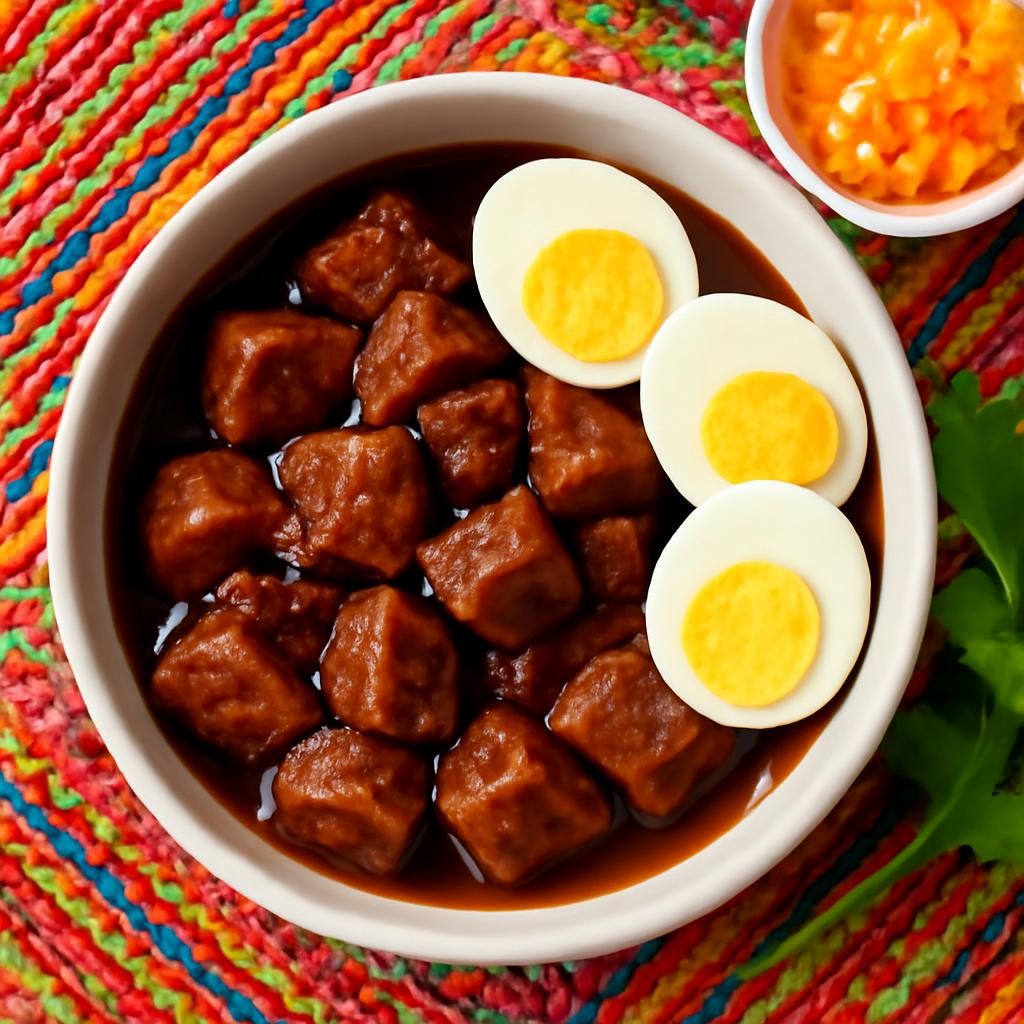Filipino Pork Adobo is a beloved dish that embodies the rich culinary heritage of the Philippines. This savory-sour stew combines tender pork belly, soy sauce, vinegar, garlic, and spices, simmered to perfection. The result is a mouthwatering dish that is both comforting and bursting with flavor. Adobo is revered for its simplicity and depth, making it a staple in many Filipino households. Whether you’re familiar with Filipino cuisine or trying it for the first time, this recipe will surely captivate your taste buds and warm your heart.

Why You Will Love This Recipe
You will love this Filipino Pork Adobo recipe for its incredible balance of flavors. The tanginess of vinegar melds beautifully with the umami of soy sauce, while the garlic adds a fragrant depth. The beauty of adobo lies in its ease of preparation; with just a few simple ingredients and one pot, you can create a dish that tastes like it’s been simmering all day. It’s perfect for busy weeknights yet impressive enough for special occasions. Plus, it naturally fits a variety of diets, providing a hearty, protein-packed meal that can be tailored to suit your lifestyle.
Tips and Tricks
- Marinate for Flavor: For the best flavor, marinate the pork in the soy sauce, vinegar, and spices for at least an hour—or overnight if you have the time. This allows the meat to absorb all those delicious flavors.
- Use a Heavy Pot: A heavy-bottomed pot or Dutch oven is ideal for even cooking. It helps prevent burning and allows for better heat retention.
- Adjust the Vinegar: If you prefer a less tangy adobo, reduce the amount of vinegar slightly. Taste as you go to find your perfect balance.
- Finish with Coconut Milk: For a creamy twist, add a splash of coconut milk towards the end of cooking for a richer sauce.
Make Ahead Tips
To make your cooking experience smoother, you can marinate the pork a day in advance. This not only saves time but also allows the flavors to deepen. The marinated pork can be stored in an airtight container in the refrigerator for up to 2 days. Additionally, any leftover adobo can be stored in the fridge for up to 4 days, making it perfect for meal prep.

Recipe Variations
- Chicken Adobo: Substitute pork with chicken thighs or drumsticks for a lighter version.
- Vegetarian Adobo: Use tofu or mushrooms for a plant-based take. Marinate and cook them in the same way.
- Spicy Adobo: Add chili peppers or a dash of chili flakes to bring some heat to the dish.
- Adobo sa Gata: Incorporate coconut milk for a creamy, richer flavor profile.
How to Serve
Serve your Filipino Pork Adobo hot over a bed of steamed jasmine rice or garlic rice to soak up the flavorful sauce. Garnish with slices of hard-boiled eggs or chopped green onions for added color and flavor. A side of pickled vegetables, known as atchara, can also complement the dish beautifully.

Pairing Suggestions
For drink pairings, a refreshing iced tea or a light Filipino beer like Red Horse can complement the flavors of adobo. If you prefer wine, a light-bodied red like Pinot Noir will work well. As for desserts, consider serving a slice of leche flan or a bowl of fresh mangoes to finish your meal on a sweet note.
How to Store
Store any leftovers in an airtight container in the refrigerator for up to 4 days. If you need to keep it longer, adobo freezes well—just make sure to cool it completely before transferring to a freezer-safe container. It can be frozen for up to 3 months. To reheat, simply thaw in the refrigerator overnight and reheat gently on the stove, adding a splash of water if needed to loosen the sauce.
Equipment Needed
- Heavy-Bottomed Pot or Dutch Oven: Essential for even cooking.
- Measuring Cups and Spoons: For accurate measurement of ingredients.
- Sharp Knife and Cutting Board: For chopping the pork and garlic.
- Airtight Container: For marinating and storing leftovers.

Dietary Adaptations
To make this recipe vegan, substitute pork with firm tofu or jackfruit, and use a plant-based soy sauce. For those with gluten sensitivities, opt for gluten-free soy sauce or tamari. You can also ensure it’s nut-free by avoiding any nut-based condiments or oils.
Seasonal Adaptations
In colder months, consider adding root vegetables such as carrots or potatoes to the dish for added heartiness. In warmer months, fresh herbs like cilantro or basil can be added just before serving for a vibrant finish.
Recipe FAQs
- Can I use other cuts of pork? Yes, you can use pork shoulder or ribs; just adjust the cooking time accordingly.
- What can I substitute for soy sauce? You can use tamari for a gluten-free option or coconut aminos for a soy-free alternative.
- How long should I marinate the pork? A minimum of 1 hour is recommended, but overnight is best for maximum flavor.
- Can I cook adobo in a slow cooker? Yes! Simply add all ingredients to the slow cooker and cook on low for 6-8 hours.
Filipino Pork Adobo

Filipino Pork Adobo is a beloved dish that embodies the rich culinary heritage of the Philippines.
Ingredients
- 2 lbs pork belly, cut into chunks
- 1 cup soy sauce
- 1 cup vinegar (preferably cane or white vinegar)
- 1 head garlic, minced
- 2-3 bay leaves
- 1 teaspoon black peppercorns
- 1 tablespoon sugar (optional)
- 2 tablespoons cooking oil
- Water (as needed)
Instructions
- Marinate the Pork: In a bowl, combine the pork belly, soy sauce, vinegar, minced garlic, bay leaves, and black peppercorns. Marinate for at least 1 hour, ideally overnight in the refrigerator.
- Sear the Pork: In a heavy-bottomed pot, heat the cooking oil over medium-high heat. Remove pork from the marinade (reserve the marinade) and sear the pieces until browned on all sides.
- Add Marinade: Pour the reserved marinade into the pot with the seared pork. Add enough water to cover the meat. Bring to a boil.
- Simmer: Reduce heat to low, cover, and let it simmer for about 30-40 minutes until the pork is tender. Stir occasionally.
- Adjust Seasoning: Taste the sauce and adjust seasoning with sugar, salt, or more vinegar if desired.
- Serve: Serve hot over rice, garnished with hard-boiled eggs or green onions.
Nutrition Information:
Yield: 6 Serving Size: 1Amount Per Serving: Calories: 529Total Fat: 37gSaturated Fat: 12gTrans Fat: 0gUnsaturated Fat: 24gCholesterol: 127mgSodium: 2480mgCarbohydrates: 6gFiber: 1gSugar: 2gProtein: 39g
Asianplated.com, occasionally offers nutritional information for recipes contained on this site. This information is provided as a courtesy and is an estimate only. This information comes from online calculators. Although allchickenrecipes.com attempts to provide accurate nutritional information, these figures are only estimates.
Final Thoughts
Filipino Pork Adobo is more than just a dish; it’s a celebration of flavors and traditions. With its robust taste and comforting aroma, it’s perfect for family meals, potlucks, or simply enjoying with loved ones. Whether you follow the traditional recipe or experiment with your variations, this dish is sure to become a cherished favorite in your kitchen. Enjoy the process of cooking, and savor every bite of this delightful Filipino classic!

